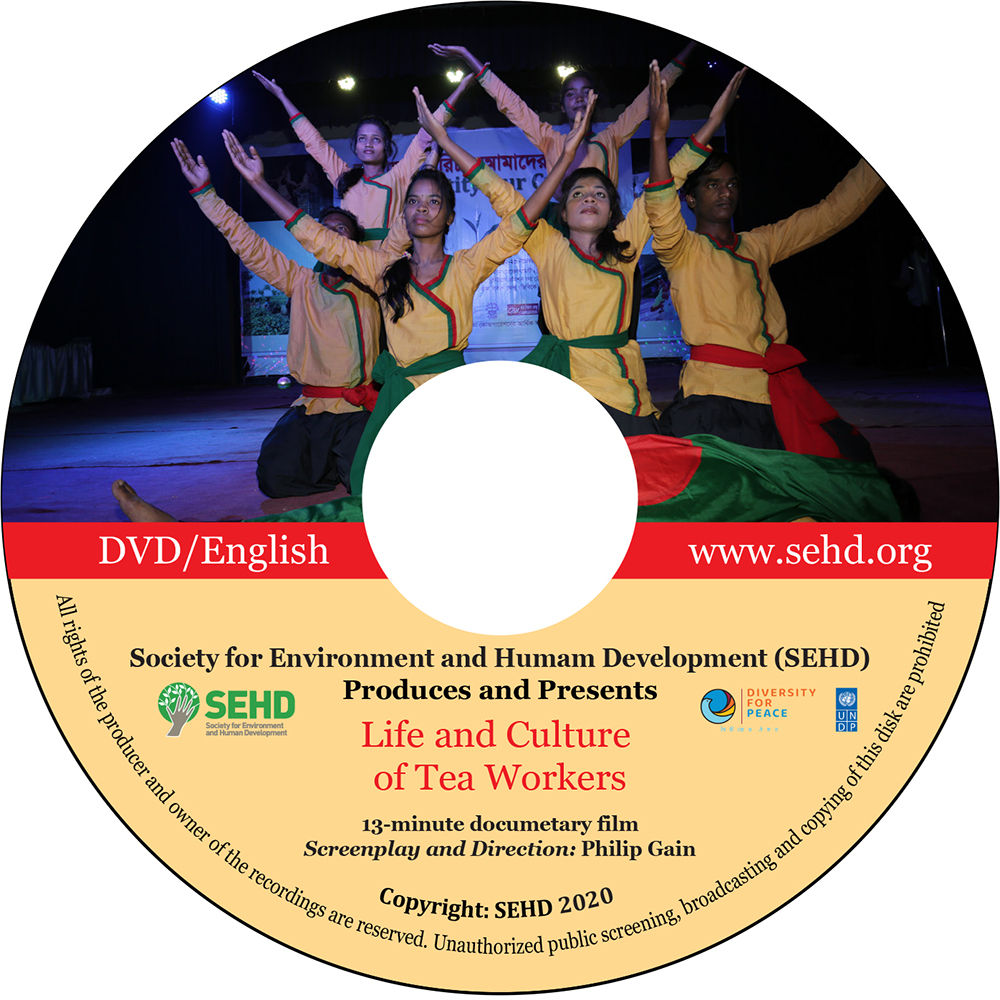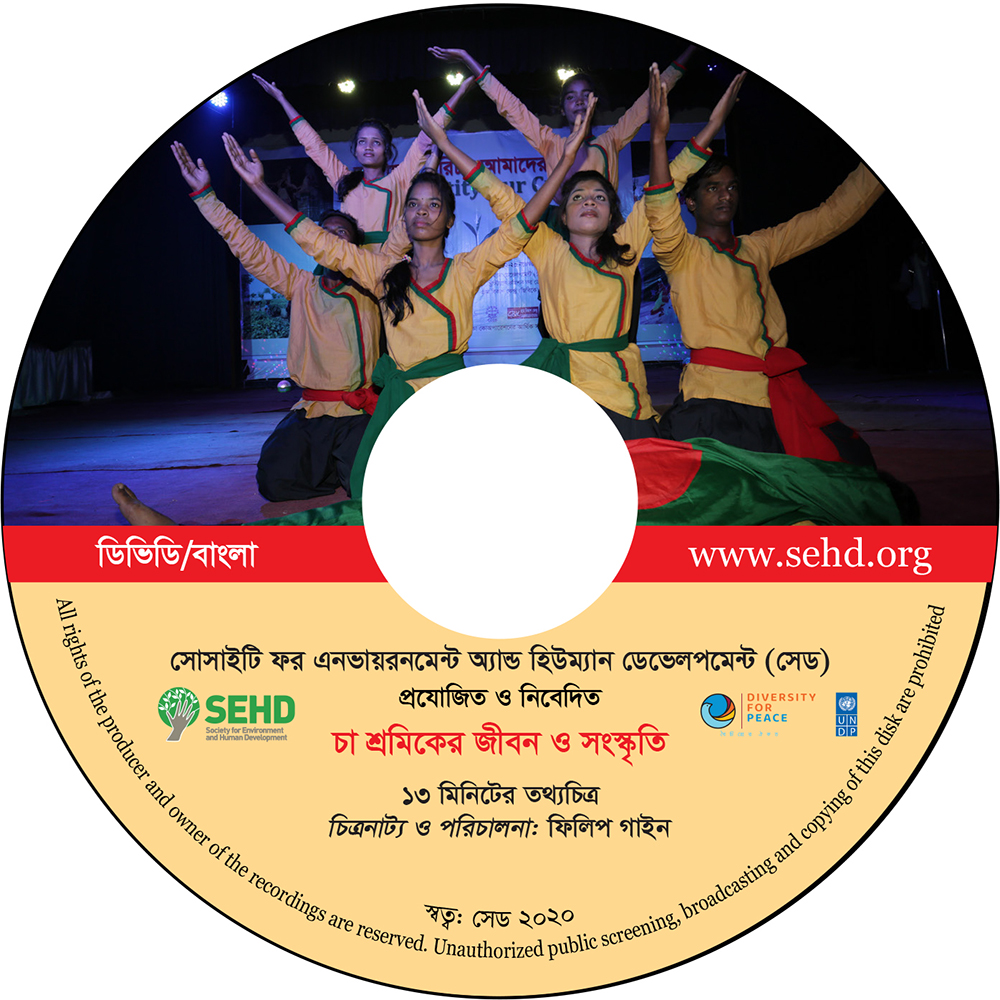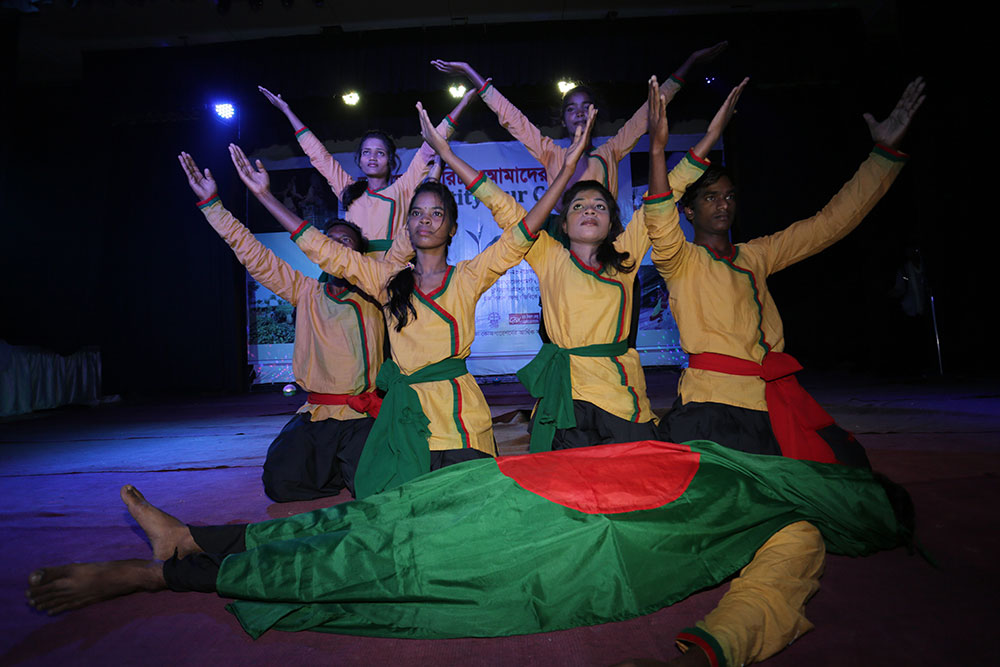Cha Sramiker Jibon O Sangskriti (Life and Culture of Tea Workers)

A 13-minutes documentary film on Life and Culture of tea workers (Bangla and English)
Screenplay and Direction: Philip Gain
Editing: Tulsi Saha
Copyright: Society for Environment and Human Development (SEHD)
Most of half a million tea workers and their communities are non-Bangalee and lower caste Hindu. Labour lines inside the tea gardens are their permanent homes without legal ownership. Their ethnic identities and the languages they speak and their cultures are amazingly diverse.
The documentary shows the life of the tea workers and their diverse cultural heritage. One of the cultural traditions of the Telugu-speaking Mandraji, Almik, Rajbhar, Tanti, Goala, Naidu, Kurmi, Teli and Reli ethnic communities is Lathi Nritto (stick dance), and Dal Nritto (branch dance). Lathi Nritto is also popular among many other ethnic communities. Lathi Nritto is integral part of any cultural event in the tea gardens.
The dance is known as Gentu Bajini to the people of Telugu ethnic community. In Telegu Gentu means jumping and Bajini means singing. We see that in the dance. Shobdokor community is has colourful cultural life with their unique musical instruments. They perform Dhamail dance and Shib Gauri dance to the rhythm of music in social and religious festivals and puja-parbans (worships). The Dhamail dance is an integral part of wedding ceremonies in the Hindu society, both inside and outside the tea garden. There is no end of dances and music among the other ethnic communities in the tea gardens.
Songs and dramas portray the sufferings, hardships, landlessness and deprivation of the tea communities. Pratik Theatre, a cultural organization based in Deundi Tea Estate in Habiganj is pioneer in this regard. More than 60 artists in this troupe regularly practice culture and drama. In the documentary some parts of their stage play Nij Bhume Parvasi can be seen. This play is about exploitation in gardens. Pratik Theatre also excels in performing patriotic dances, songs and stage plays.
The Manipuri and the Khasi, the closest neighbours to the tea workers, are sometimes seen together on the cultural stage. Just as the war dance of the Khasi and the Mridanga and Raas dance of the Manipuri paint colours on the stage and hugely amuse the audience.
The dances, dramas and yard culture of tea communities are very colourful and diverse. Their cultural performances are appealing not only among themselves, but also to their neighbouring majority Bangalees. Unfortunately, negligence has led to many of their languages and much of their cultural heritages. Their diverse languages and cultures should be protected along with the Bangalee language and culture. The documentary, ‘Life and Culture of Tea Workers’ conveys the message that cultural practice and exchange can strengthen the bridge between the tea communities and the Bangalee majority and state support and attention of the majority can protect their language and culture.
YouTube link: Cha Sramiker Jibon O Sangskriti
চা শ্রমিকের জীবন ও সংস্কৃতি

চা শ্রমিকদের জীবন ও সংস্কৃতি নিয়ে ১৩ মিনিটের প্রামাণ্যচিত্র (বাংলা ও ইংরেজি)
চিত্রনাট্য ও পরিচালনা: ফিলিপ গাইন
সম্পাদনা: তুলসী সাহা
স্বত্ব: সোসাইটি ফর এনভায়রনমেন্ট অ্যান্ড হিউম্যান ডেভেলপমেন্ট (সেড), ২০২০
চা-শ্রমিক ও তাদের পরিবার-পরিজন নিয়ে পাঁচ লাখের মতো চা-জনগোষ্ঠীর মানুষের অধিকাংশ হিন্দু ধর্মাবলম্বী এবং তারা বাঙালি নন। চা-বাগানের অভ্যন্তরে লেবার লাইনই তাদের স্থায়ী ঠিকানা। সবচেয়ে চমকপ্রদ বিষয় হলো এসব মানুষের জাতিগত পরিচয়, ভাষা ও সংস্কৃতি খুবই বৈচিত্র্যপূর্ণ।
তথ্যচিত্রটি চা শ্রমিকদের জীবন ও তাদের বৈচিত্র্যপূর্ণ সাংস্কৃতিক ঐতিহ্যকেই আমাদের সামনে তুলে ধরেছে। তেলেগুভাষী মান্দ্রাজি, অলমিক, রাজভর, তাতী, গোয়ালা, নাইডু, কুর্মি, তেলি ও রেলি জাতিগোষ্টীর অন্যতম সাংস্কৃতিক ঐতিহ্য লাঠিনৃত্য ও ডালনৃত্য। অন্য অনেক জাতিগোষ্ঠীর মধ্যেও লাঠিনৃত্য জনপ্রিয়। চা বাগানে যেকোনা সাংস্কৃতিক অনুষ্ঠানে লাঠিনৃত্য থাকাটা স্বাভাবিক। ডালনৃত্য তেলেগু জাতিগোষ্ঠীর মানুষের কাছে “গেন্তু বাজিনী” নামে পরিচিত। তেলেগু ভাষায় ‘গেন্তু’ মানে লাফানো আর ‘বাজিনী’ মানে কীর্তন। ডালনৃত্যে আমরা সেটাই দেখি।
চা বাগানের মানুষের দু:খের কথা, কষ্টের কথা, ভূমিহীনতার কথা এবং বঞ্চনার কথা চিত্রায়িত হয় নানা গান ও নাটকে। হবিগঞ্জের দেউন্দি চা-বাগানভিত্তিক প্রতীক থিয়েটার এ ব্যাপারে পথ প্রদর্শক। তথ্যচিত্রে তাদের ‘নিজ ভূমে পরবাসী’ মঞ্চনাটকের কিছু অংশ দেখা যায়। এ নাটকটি চা-বাগানে শোষণের কথা বলে। দেশাত্মবোধক নৃত্যগীতি ও মঞ্চনাটক পরিবেশনায়ও প্রতীক থিয়েটার পারদর্শী।
সাংস্কৃতিক মঞ্চে চা-শ্রমিকের নিকটতম প্রতিবেশী মণিপুরি ও খাসিদেরকে মাঝেমধ্যেই একসাথে দেখা যায়। খাসিদের যুদ্ধের নাচ আর মণিপুরিদের মৃদঙ্গ ও রাসনৃত্য যেমন মঞ্চ রাঙায়, তেমনি রাঙায় দর্শকের মন।
এতো বর্ণিল আর বৈচিত্র্যে ভরা চা জনগোষ্ঠীর নৃত্যগীতি, নাটক-নাটিকা এবং উঠান সংস্কৃতি। শুধু নিজেদের মধ্যেই নয়, প্রতিবেশী সংখ্যাগরিষ্ঠ বাঙালিদের মধ্যেও আবেদন সৃষ্টি করে তাদের সাংস্কৃতিক পরিবেশনা। কিন্তু পরিতাপের বিষয় অযত্নে-অবহেলায় তাদের ভাষা ও সংস্কৃতির অনেক কিছুই হারিয়ে গেছে। বাংলা ভাষা ও বাঙালি সংস্কৃতির পাশাপাশি এদের নানান ভাষা ও সংস্কৃতির সুরক্ষা নিশ্চিত হওয়া দরকার। সংস্কৃতি চর্চা ও বিনিময়ই যে চা জনগাষ্ঠী ও সংখ্যাগরিষ্ঠ বাঙালির মাঝে সেতুবন্ধন সুদৃঢ় করতে পারে এবং রাষ্ট্রীয় পৃষ্ঠপোষকতা আর সংখ্যাগরিষ্ঠের মনোযোগই যে পারে তাদের ভাষা সংস্কৃতির সুরক্ষা দিতে সে বার্তাই দেয় ‘চা শ্রমিকের জীবন ও সংস্কৃতি’ তথ্যচিত্রটি।
YouTube link: চা শ্রমিকের জীবন ও সংস্কৃতি

